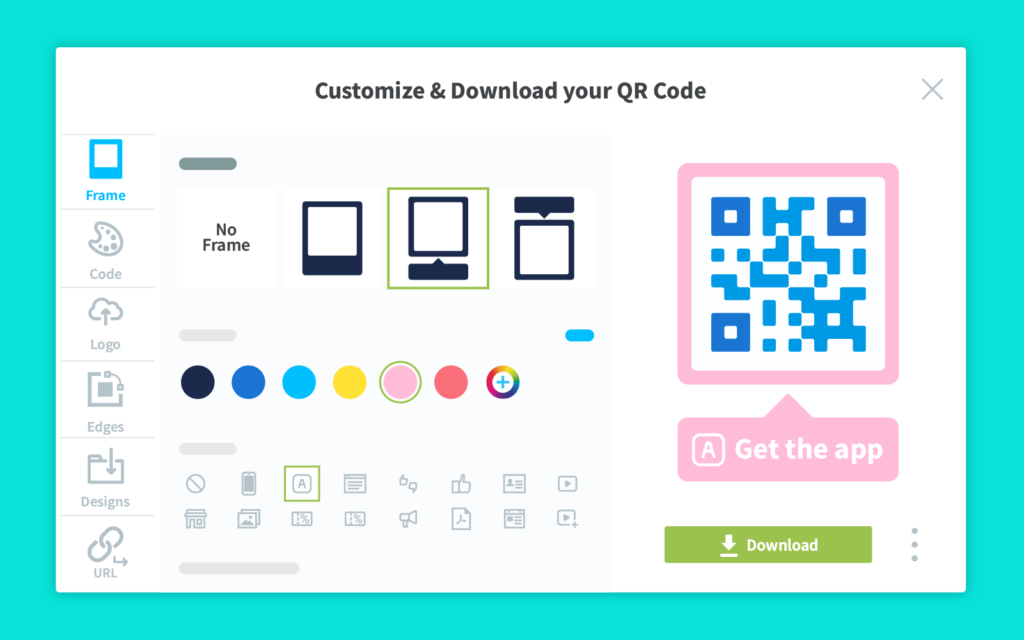- Best Practices ●
- COVID-19 ●
- Industry Trends ●
- Partners ●
- Product ●
Your Essential Guide to Mobile Marketing With QR Codes
Smartphones have completely changed the communication game. With these small devices, consumers have access to the whole world at their fingertips.
Since smartphones have boomed in popularity, mobile marketing has become one of the most effective ways for brands to reach their target audiences. With mobile marketing, you use ads and other promotional strategies to reach consumers directly through their phones and tablets.
QR Codes can play an essential role in your mobile marketing strategy. These small barcodes can take your audience to webpage links, social media pages, app downloads, and more with a quick scan.
Here’s a look at some of the latest mobile marketing trends and how you can use QR Codes to bring your mobile marketing campaigns to life.
Why is mobile marketing important?
Put simply, mobile marketing is any form of marketing where you connect with consumers via a mobile device.
The most successful mobile marketing strategies use a range of tools to capture audience attention, including social media, text messaging, and of course, QR Codes. You can use QR Code marketing for apps, landing pages, and a variety of other digital assets.
Mobile marketing is a must for modern businesses due to the sheer amount of time that today’s consumers spend on their phones. The average American checks their phone 144 times per day. If your business doesn’t have a mobile marketing strategy, you’re missing out on a huge opportunity to connect with your audience.
In fact, many consumers now prefer to go online on their phones instead of using a desktop computer. Around 76% of adults have made purchases online using their smartphones, indicating just how widespread online browsing has become.
Mobile marketing makes your business more visible and more accessible to those who prefer to browse the internet on their mobile phones.
Components of mobile marketing to know
Successful mobile marketing strategies are multifaceted and contain several different components. These components work together to engage your audience and, ultimately, turn user engagement into sales. Here are the key components of mobile marketing to be aware of.
Personalized mobile marketing
This strategy uses consumer data to personalize mobile marketing materials for each recipient. Sending personalized SMS or MMS messages will quickly get the recipient’s attention and create a more engaging experience.
There are many different ways to personalize these marketing campaigns based on the information you have available. For example, if you’re messaging an existing customer, you can personalize the message with their name. You can also send special offers for their birthday or holidays.
Even if you don’t have a customer’s name or birthday, you can still tailor the message to them based on the data you do have. For example, you can segment your customers based on location and send messages that are specific to their geographic market.
You can also segment customers based on where they are in the sales funnel. Say they’ve looked at a product on your mobile app but haven’t made a purchase. You could send a message with a coupon for that specific item to pull them back in.
Mobile-only ads
Mobile ads are designed specifically for viewing on a smartphone or tablet, rather than a desktop computer. They’re formatted for smaller screens and work seamlessly in a mobile environment.
There are many different types of mobile ads. Google automatically formats its PPC ads for mobile, so you’ll see them when browsing the internet on your mobile device.
Major social media networks like Facebook, Instagram, TikTok, and LinkedIn all have advertising options that work in their mobile apps. Users will see these ads in their feeds while scrolling. You can include QR Codes in your social media marketing strategy to make it easy for users to visit your website or landing page.
Many popular mobile apps use advertising as part of their business model. For example, mobile games often have interactive ads that pop up in between levels. Some apps also have dedicated spaces for display ads or banner ads.
Strategically placed mobile ads are an effective way to boost brand awareness among new audiences. Since mobile ads are interactive, they can also drive traffic to your website or mobile app.
Mobile websites and apps
In today’s digital environment, having a mobile website is a must. Mobile websites automatically adjust their layout and font size when opened on a smartphone, making them easier to read on these small devices. This ensures that you provide a great user experience, no matter which device users are on.
You can also take things a step further with your own mobile app in the Apple App Store or Google Play Store. With a mobile app, you can offer more fun and interactive features for your users than you would on your website.
QR Code marketing
QR Codes are an important tool for linking your offline and online marketing strategies together. For example, users can scan QR Codes on billboards, fliers, business cards, print ads, and more with their phone cameras. The QR Code will take them to a landing page, social media profile, app download, or other digital asset on their phone.
This is a quick and efficient way to share information and turn successful offline marketing strategies into potential customers. You can also use QR Codes to create interactive multimedia experiences for your audience.
Location-based marketing
Smartphones have GPS technology, and you can use this technology as part of your mobile marketing strategy. If you have an app, you can deliver special deals or other interactive features to users based on their location.
This is a particularly helpful strategy if your brand has brick-and-mortar stores or hosts in-person events. You can use mobile marketing to enhance these events and create an interactive experience.
Voice-search optimization
Many people rely heavily on voice search tools rather than typing their queries into Google. In fact, 62% of American adults use voice search on at least one of their devices.
Voice search optimization is the process of identifying relevant voice search terms and incorporating them into your brand’s digital marketing content. With this strategy, you can capitalize on the popularity of voice search tools and drive more traffic to your website.
Top benefits of QR Codes in a mobile marketing strategy
The use of QR Codes in your mobile marketing strategy can help increase customer engagement with your digital content and build brand awareness. Here’s why QR Codes should be a big part of your mobile marketing efforts.
Location-based tracking

Location-based mobile marketing is tricky. This strategy works well in some environments but may not generate as much engagement in others. Dynamic QR Codes have location-based tracking features, which you can use to identify where each scan comes from.
This will help you identify places where location-based marketing is most effective. For example, say you place QR Codes throughout the city linking to your app downloads. The QR Codes in train stations consistently get the most scans, indicating that you should focus your location-based marketing on public transit.
More granular analytics
Google Analytics can help you track the entire customer journey online, from the first time they interact with your website until they make a purchase.
QR Code Generator PRO pairs well with Google Analytics to give you a more comprehensive look at the customer journey. You’ll be able to see how many website views come from QR Code scans and determine your conversion rate from there.
Better brand awareness from custom design

Customize App Store QR Code frames, icons, edges, logo, and colors
Dynamic QR Codes are easy to customize to suit your brand identity. You can add your logo and a call-to-action to the QR Code to give it a professional appearance and make it more enticing.
You can also change the QR Code’s colors and patterns to align with your existing brand image. This gives your marketing assets a more cohesive look and also makes your QR Codes appear more trustworthy, so users will be more likely to scan them.
Improved email open rates
Including QR Codes in your emails can help you improve your email open and engagement rates. Say your email marketing strategies contain links to your e-commerce site or your app.
If recipients open these emails on their desktop computers, they won’t have an easy way to navigate to these links on their phones. However, if you include a QR Code in the email, the recipient can scan the QR Code with their mobile phone and navigate quickly to their desired links.
More opportunities for innovation
With QR Codes, you can develop an innovative mobile marketing strategy to generate buzz and impress your audience.
One of the best examples of this is using QR Codes to link to interactive augmented reality (AR) experiences. AR integrates digital content with real-world environments, and it’s one of the hottest trends in mobile marketing right now.
For example, a furniture store could have QR Codes next to each piece linking to an app where you can superimpose the furniture on photos of your space. This would help you visualize the piece in your home before purchasing it. There are so many exciting new ways to use AR technology to engage your customers.
How to add and use QR Codes in your mobile marketing campaigns
Adding QR Codes to your mobile marketing strategy is a very straightforward process. Here’s how to create mobile QR Code campaigns that resonate.
Step 1: Define your target audience
Before you launch your marketing campaign, you’ll need to determine who your target audience is, what their interests are, and what marketing channels will be most effective to reach them. Defining your target audience ahead of time will help you tailor your marketing campaign to them and create assets that convert.
Step 2: Create and customize your QR Code
Once you’ve decided who your target audience is, the next step is to create a QR Code using QR Code Generator PRO. The platform makes it easy to generate your QR Code and customize elements like the colors, pattern, and border. You can also add your logo to the center of the QR Code.
Step 3: Integrate QR Codes into your marketing materials
The next step is to decide where you want your QR Codes to link to. QR Codes can link to many different types of digital assets, including landing pages, app downloads, social media pages, and more. You can even use video marketing with QR Codes to link to short-form videos.
You’ll also need to add the QR Codes to your marketing assets, such as your print ads, email marketing campaigns, billboards, and fliers. These QR Codes should be large enough to scan and clearly labeled with a CTA so viewers know how to use them and what to expect.
Step 4: Test, launch, and track the campaign
Before launching your QR Code campaign, test it on a variety of devices to make sure the code scans and loads properly. After testing, launch the campaign and track it using analytics features. Take note of your QR Code metrics and use them to improve future campaigns.
Make your mobile marketing better with QR Code Generator PRO
No matter who your audience is, there’s a strong chance the majority of them regularly use smartphones. So you need an effective mobile marketing strategy to meet your customers where they are. Well-designed QR Codes will help you increase engagement with your mobile marketing and connect more users with your brand.
QR Code Generator PRO has the advanced features you need to create eye-catching, professional QR Codes for your brand. Choose from dozens of different QR Code types for every use case and customize each one to fit your brand style.
Sign up today to take your mobile marketing strategy to the next level with QR Codes.






 Add custom colors, logos and frames.
Add custom colors, logos and frames.

